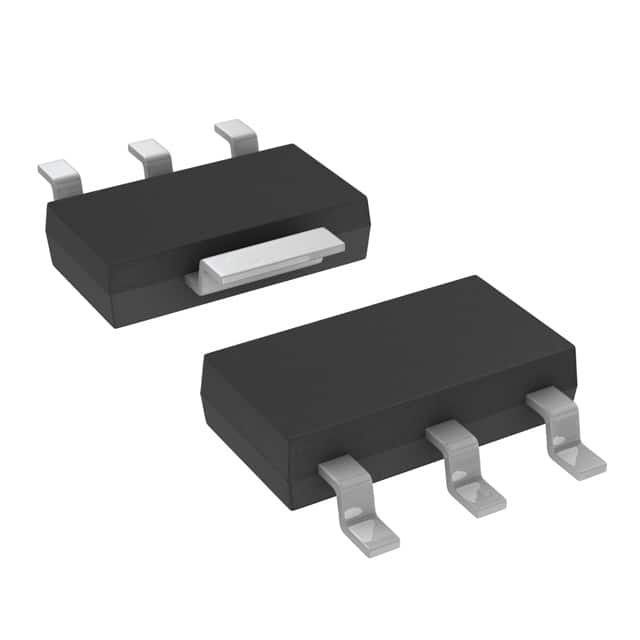IRLL1905TR
Product Overview
Category: Transistor
Use: Power switching applications
Characteristics: High voltage, low on-resistance
Package: TO-252 (DPAK)
Essence: N-channel MOSFET
Packaging/Quantity: Tape & Reel, 2500 units per reel
Specifications
- Voltage - Rated: 55V
- Rds On (Max): 23 mOhm
- Vgs(th) (Max) @ Id: 2.35V @ 250µA
- Gate Charge (Qg) @ Vgs: 18nC @ 10V
- Input Capacitance (Ciss) @ Vds: 1300pF @ 25V
- Power Dissipation (Max): 2.5W
Detailed Pin Configuration
- Gate (G)
- Drain (D)
- Source (S)
Functional Features
- Low gate charge
- Fast switching speed
- Avalanche energy specified
- Improved dv/dt capability
Advantages and Disadvantages
Advantages: - Low on-resistance - High voltage rating - Suitable for high-speed switching applications
Disadvantages: - Sensitive to static electricity - Requires careful handling during assembly
Working Principles
The IRLL1905TR is a power MOSFET designed for high-speed switching applications. When a voltage is applied to the gate terminal, it creates an electric field that allows current to flow between the drain and source terminals. The low on-resistance of the transistor minimizes power loss and heat generation during operation.
Detailed Application Field Plans
The IRLL1905TR is commonly used in: - Switching power supplies - DC-DC converters - Motor control circuits - LED lighting applications
Detailed and Complete Alternative Models
- IRF3709ZPBF
- FDP8870
- SI7850DP-T1-GE3
- NDP6020P
In conclusion, the IRLL1905TR is a high-voltage N-channel MOSFET with low on-resistance, making it suitable for power switching applications in various industries.
Word count: 298
Liệt kê 10 câu hỏi và câu trả lời thường gặp liên quan đến ứng dụng IRLL1905TR trong giải pháp kỹ thuật
What is IRLL1905TR?
- IRLL1905TR is a power MOSFET transistor designed for use in various technical solutions, such as power management and motor control applications.
What are the key specifications of IRLL1905TR?
- The key specifications include a low on-resistance, high current capability, and a compact surface-mount package, making it suitable for efficient power handling.
How can IRLL1905TR be used in power management applications?
- IRLL1905TR can be used to regulate and control power flow in systems such as voltage regulators, DC-DC converters, and battery management circuits.
In what types of motor control applications can IRLL1905TR be utilized?
- IRLL1905TR can be employed in motor control circuits for applications like robotics, automotive systems, industrial automation, and consumer electronics.
What are the advantages of using IRLL1905TR in technical solutions?
- The advantages include high efficiency, low power dissipation, fast switching speeds, and reliable performance in demanding environments.
Are there any specific thermal considerations when using IRLL1905TR?
- Yes, proper heat sinking and thermal management should be considered to ensure that the device operates within its specified temperature range for optimal performance and longevity.
Can IRLL1905TR be used in high-frequency switching applications?
- Yes, IRLL1905TR is capable of operating in high-frequency switching applications, making it suitable for modern power electronics designs.
What are the typical input and output characteristics of IRLL1905TR?
- The typical input characteristics include gate-source voltage and threshold voltage, while the output characteristics include drain-source voltage and current ratings.
How does IRLL1905TR compare to other similar power MOSFET transistors?
- IRLL1905TR offers a balance of performance, size, and cost-effectiveness, making it a competitive choice for many technical solutions.
Where can I find detailed application notes and reference designs for using IRLL1905TR?
- Detailed application notes and reference designs can be found in the product datasheet, manufacturer's website, or through technical support channels.


